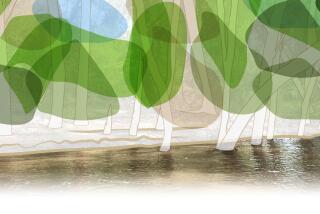Canoe Artist Keeps Craft Afloat for Film Role
VERGENNES, Vt. — Bart Howe makes canoes as northeastern American Indians did hundreds of years ago--with birch bark, spruce gum, animal fat and roots. Only his don’t navigate primeval rivers: One will appear in a movie.
To fashion his canoes, Howe carves thwarts and gunnels, stretches the bark tight by hand over them and sews the seams with spruce roots. Differences in canoes’ details reflect different tribes’ methods.
He has been working with a movie crew in Vermont making a feature film, “Where The Rivers Flow North,” using one of his canoes.
“They needed an old beat-up looking canoe,” Howe said. “So I worked on one of mine and modified it to look like one that might have been built in the early 1900s by the Akenabi Indians up in Quebec, then used hard for a couple of decades, to bring it into the right historical period.”
The Caledonia Pictures movie, directed by Jay Rivers, is set in 1927 and stars Rip Torn as an old Yankee log driver.
“This is a craft that’s certainly all but lost,” said Donald Dewees, operations manager at the Basin Harbor Maritime Museum, where Howe was a resident boat builder last summer. “There are only a few people around the country who know how to construct boats in this antique manner.”
Howe says he tries to be as authentic as possible. The canoes “are made from trees and little else, except for nails . . . nails were quickly brought into use by boat builders at the time iron was introduced.”
Howe began his career of crafting canoes by finding the perfect white birch tree.
After looking for years at this tree on his Huntington property, thinking it would make a good canoe someday, he made the first boat a little more than a year ago. He has been making them compulsively ever since.
“Something about birch bark canoes has fascinated me for years, since I was a boy,” said Howe, 40.
As long as 20 years ago he bought the book by Edwin Adney, “Bark Canoes and Skin Boats of North America,” that has given him much of the detail and process of canoe building.
“In the late 1800s, Adney devoted his life to collecting thousands of pages of notes on canoes,” he said. “If he hadn’t been nutty enough to do that, we wouldn’t have these details today. Most of what we know about boats would not have been preserved.”
Now he builds canoes for part of the year--”it’s a warm-weather job,” he says--and supports himself with carpentry the rest of the time.
At an average price of about $3,000 a canoe, Howe said his market is limited. A genuine birch bark canoe does not have the flash and sleekness of a modern fiberglass canoe and would not please some boating enthusiasts as much, he says.
Howe starts by peeling the bark off a birch tree all in one piece. He stakes out the canoe’s shape and length and carves its sides and ribs. Then he pulls the birch bark around the ribs to keep the canoe in shape, with the white side of the bark on the inside.
“The effect is quite striking,” Dewees said. “This was one of the details that interested me the most--the sequence of building the canoe from the outside in.”
More to Read
Sign up for The Wild
We’ll help you find the best places to hike, bike and run, as well as the perfect silent spots for meditation and yoga.
You may occasionally receive promotional content from the Los Angeles Times.





